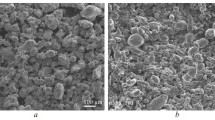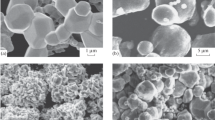Abstract
Hydrogen-induced pulverization allows the production of fine powders with high purity and low cost in refractory metals, alloys, and intermetallics. In this paper, their hydrogen pulverization behavior has been investigated in order to further utilize hydrogen pulverization as a new powder fabrication process. Hydrogen pulverization was examined by the following three methods: (i) hydrogenation in an arc-melting chamber for NbCr2 and Ta2Ni alloys; (ii) measurement of hydrogen absorption-desorption curves in a Sieverts-type apparatus for Nb3Al alloys; and (iii) heat treatment in a hydrogen furnace for pure Ta. Two-phase alloys of NbCr2/Nbss, Nb3Al/Nbss, Nb3Al/Nb2Al, Ta2Ni/Tass and Tass/Ta2H (Nbss and Tass denote Nb and Ta solid solutions, respectively) are pulverized by absorbing a large amount of hydrogen. It is suggested that cracking leading to pulverization is initiated at brittle intermetallic regions or hydrides, which are fractured by lattice expansion of Nbss or Tass due to hydrogen absorption.
Similar content being viewed by others
References
C. C. Wojcik,High Temperature Niobium Alloys (eds., J. J. Stephens and I. Ahmad), p. 1, TMS, Warrendale, PA (1991).
R. H. Burns, J. C. Fang, and P. Kumar,Tantalum (eds., E. S. Chen, A. Crowson, E. Lavernia, W. Ebihara, and P. Kumar), p. 273, TMS, Warrendale, PA (1996).
M. Kosuge, H. Hosoda, and S. Hanada,J. Jpn. Inst. Met. 62, 681 (1998).
D. J. Thoma and J. H. Perepezko,Mater. Sci. Eng. A 156, 97 (1992).
J. F. Smith,Binary Phase Diagram (ed., T. B. Massalski), p. 1271, ASM, Metals Park, OH (1983).
J. Vökl and G. Alfred,Hydrogen in Metals I, Topics in Applied Physics 28 (eds., J. Vökl and G. Alfred), p. 321, Springer-Verlag, Berlin (1978).
Powder Diffraction File (eds., W. F. McClune, B. Post, S. Weissmann, and H. F. McMurdie), JCDDS International Center Diffraction Data, Swarthmore, PA (1984).
J. L. Jorda, R. Flüiger, and J. Muller,J. Less-Common Met. 75, 227 (1980).
P. Nash and D. R. F. West,Met. Sci. 17(2), 99 (1983).
T. Scober and A. Carl,Scripta metall. 11, 397 (1977).
Author information
Authors and Affiliations
Corresponding author
Additional information
This article is based on a presentation made in the symposium “The 3rd KIM-JIM Joint Symposium on Advanced Powder Materials”, held at Korea University, Seoul, Korea, October 26–27, 2001 under auspices of The Korean Institute of Metals and materials and The Japan Institute of Metals.
Rights and permissions
About this article
Cite this article
Semboshi, S., Masahashi, N. & Hanada, S. Hydrogen pulverization of refractory metals, alloys and intermetallics. Met. Mater. Int. 10, 45–53 (2004). https://doi.org/10.1007/BF03027363
Issue Date:
DOI: https://doi.org/10.1007/BF03027363




